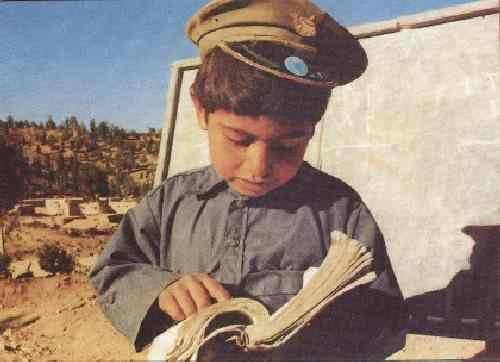
Figure 1.--This boy wears a shirt style common in Afghanistan today. The military cap is probably part of the uniform of a soldier that the boy has obtained. |

|
HBC at this time has very little information on Afghani schoolwear. Clothing styles have been strongly affected by social trends and rule by a communist government, rigid Tailaban theocracy, 20 years of democracy, and nowe renewd Taliban theocracy.
Afganistan is a country unfamilar to most Americams. Thus a brief survey of the country's history is necessary to understand Afgani fashion. Afganistan in fact has an incredibly interesting history. Many of the major towns were founded by Alexander the Great. Islam was spread to Afghanistan by the Turks who with the Mongols, Persians, and Indian Moguls have ruled the country. The 19th century found Afghanistan as the center of the "Great Game" pitting the Russians in Central Asia with the British in India. Many royal regimes appeared in Afganistan which both welcomed the British and delivered disastrous military defeats. Much of the subsequent history of Afganistan has been the tension betwwen wester reformers andIslmaic fundamentalists. More than one Afgani king has been deposed and killed by the fundamentalists. Nadir Shah established a constitutional monarchy in 1932. Despite efforts by NAZI infiltrators, Afghanistan stayed neutral during World War II. After the war the king was deposed and by the 1970s an incresingly pro-Soviet government communist sought tp modernize the country through often brital measures This was met by increasingly successful resistance from the Muhajedeen. The Soviet Union invaded Afghanistan in 1979 to support the beleagered coounist regime. After 10 years of bitter fighting, the Soviets finally withdrew, leaving their Afghani allies to their fate. Afghanistan is still a country in which an armed conflict over power between opposing political factions continues. Afghanistan has in the process been devastated, producing the world's largest ever single refugee case-load, at times as high as 6.2 million persons. Throughout the following years while a bitter struggle over power between the various muhajedeen groups ensued with the strict fundamentalist Tailaban now controling most of the country.
|
The wrenching political changes in Afghanistan affected clothing. The communist government that ruled in Kabul adopted western dress for both children and adults, although in rural villages traditional clothing was still common. After the Soviet departure in 1989, traditional dress has returned. The rise of the Tailaban has acceleated this trend, including the most extreme forms of Islamic dress for girls and women. Interestingly the closed-front or Rugby-style shirt appears to have originated from the Islamic world.
HBC has little information about Afghani schoolwear at this time. HBC does nir believe that Afganistani boys do not wear school uniformsm although we have little information on trends during the communist era. Afghani boys do wear some distinctive fashions to school--including the long shirt that has become so popular with the Tailban. Girls have been almost totally excluded from schools and education outside the home.
|
Carefull, clicking on these will exit you from the Boys' Historical Clothing web site, but several are highly recommended
Related Chronolgy Pages in the Boys' Historical Web Site
[The 1880s]
[The 1890s]
[The 1900s]
[The 1910s]
[The 1920s]
[The 1930s]
[The 1940s]
[The 1930s]
[The 1940s]
[The 1950s]
[The 1960s]
[The 1970s]
[The 1980s]
Related Style Pages in the Boys' Historical Web Site
[Long pants suits]
[Knicker suits]
[Short pants suits]
[Socks]
[Eton suits]
[Jacket and trousers]
[Blazer]
[School sandals]
[School smocks]
[Sailor suits]
[Pinafores]
[Long stockings]
Navigate the HBC School Section
[Return to the Main Asian country school page]
[Return to the Main country school page]
[Return to the Main Afghani page]
[About Us]
[Activities]
[Chronology]
[Clothing styles]
[Countries]
[Debate]
[Economics]
[Garment]
[Gender]
[Hair]
[History]
[Home trends]
[Literary characters]
[School types]
[Significance]
[Transport and travel
[Uniform regulations]
[Year level]
[Other topics]
[Images]
[Links]
[Registration]
[Tools]
[Return to the Historic Boys' School Home]
